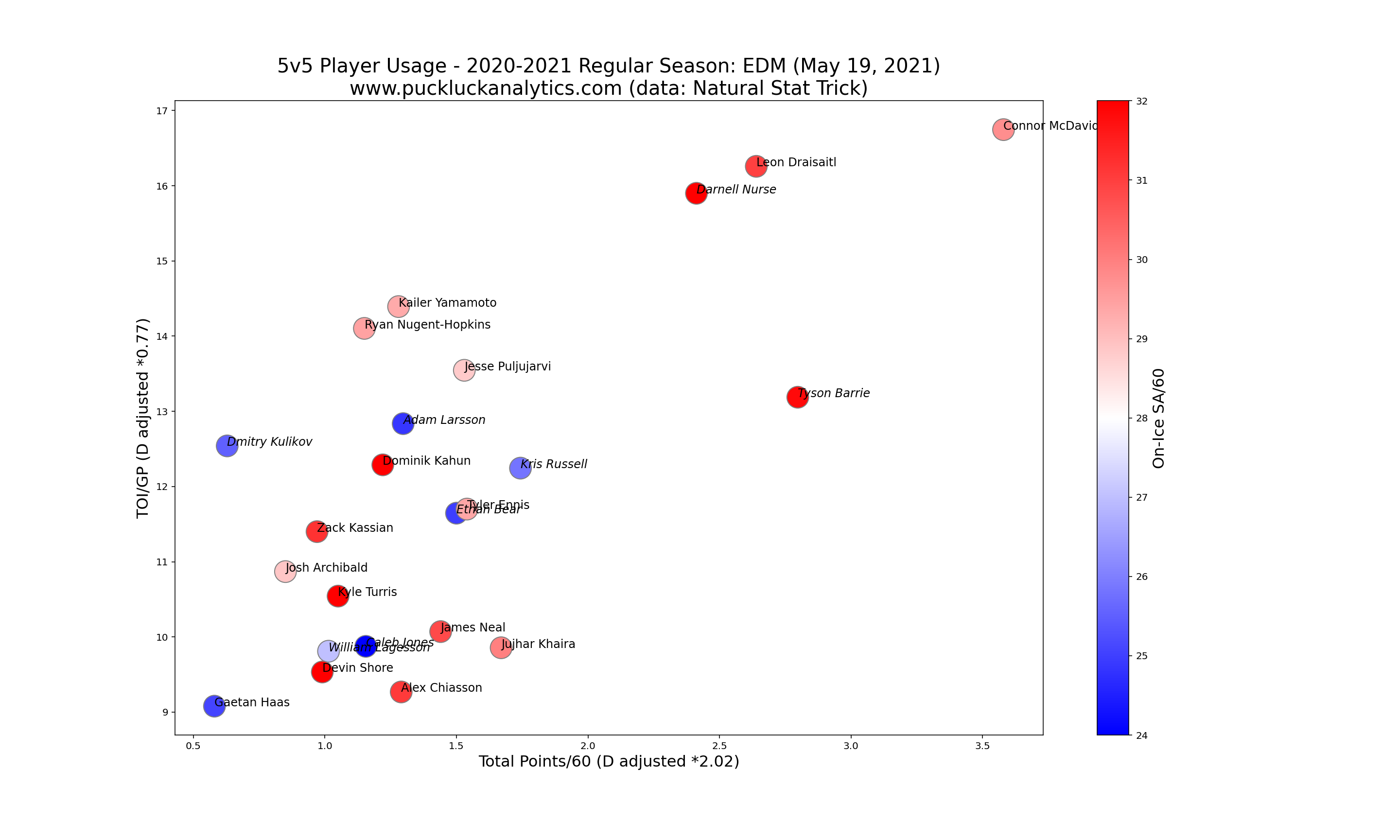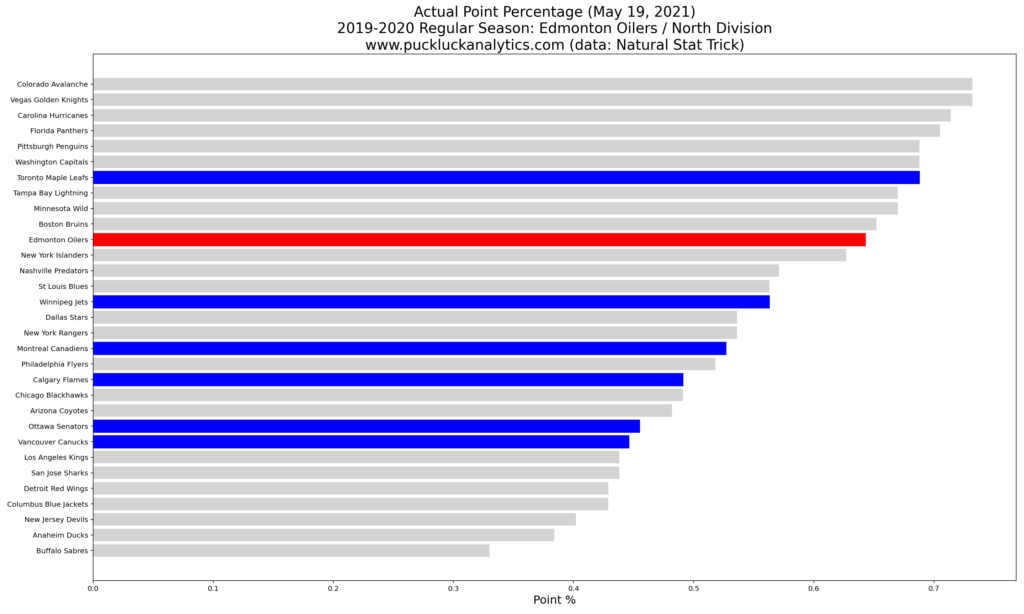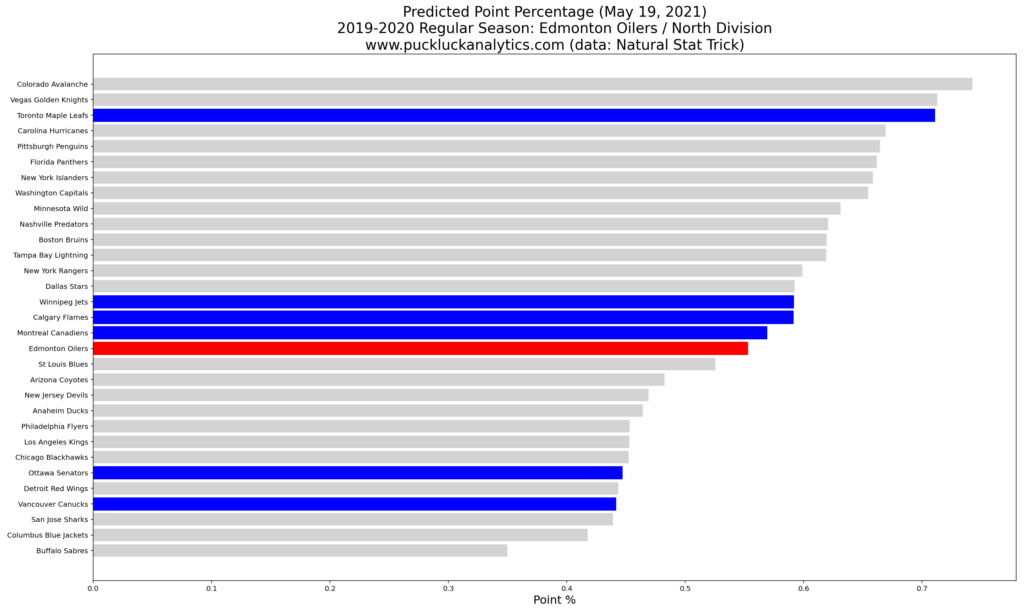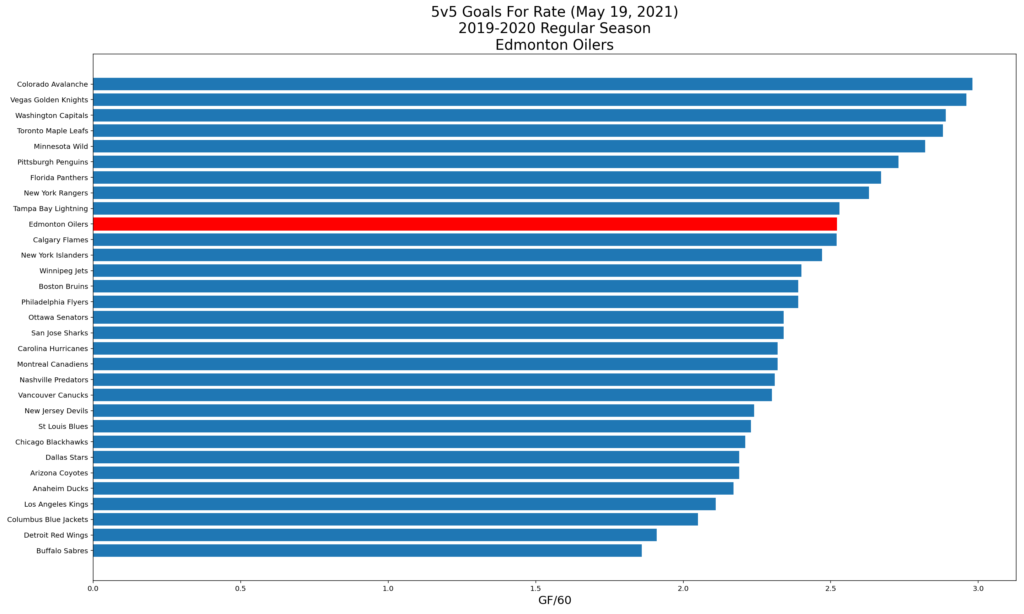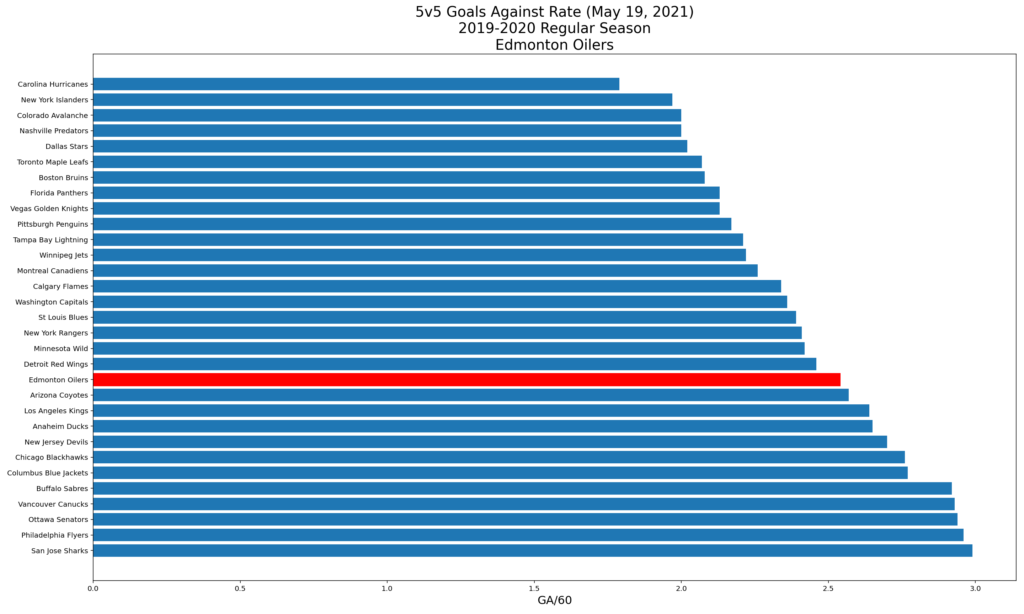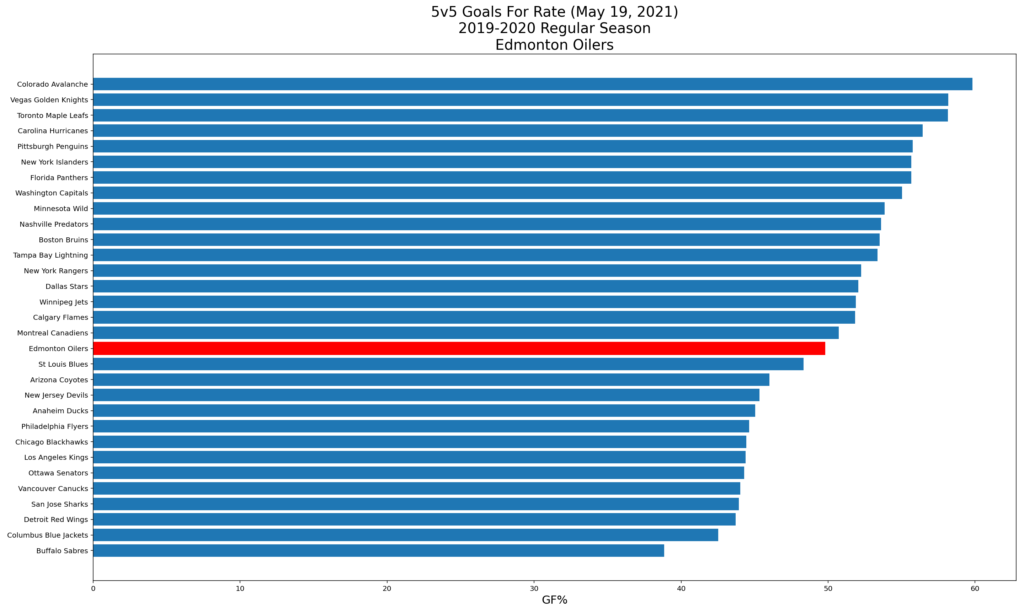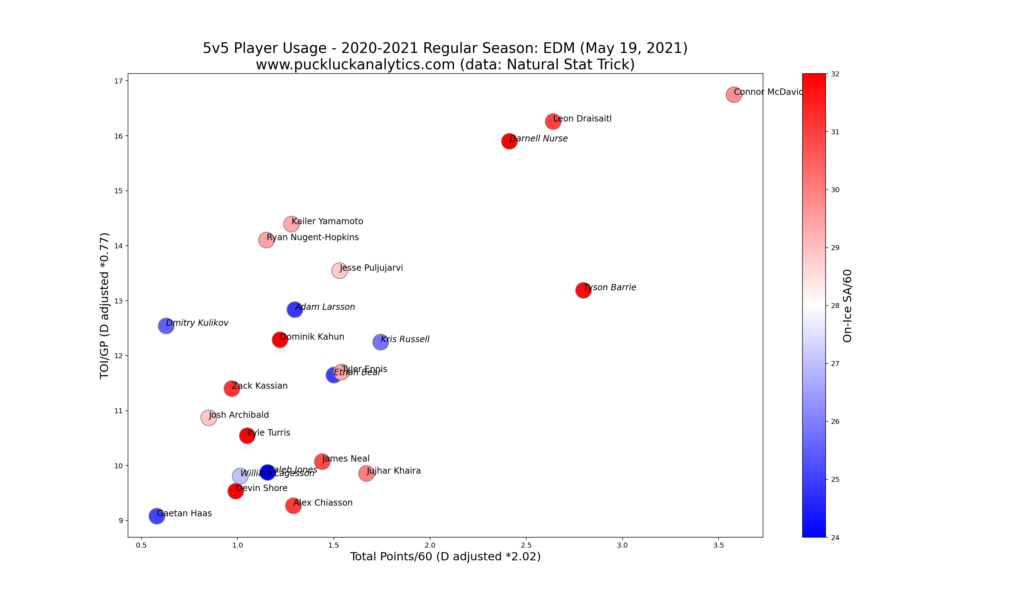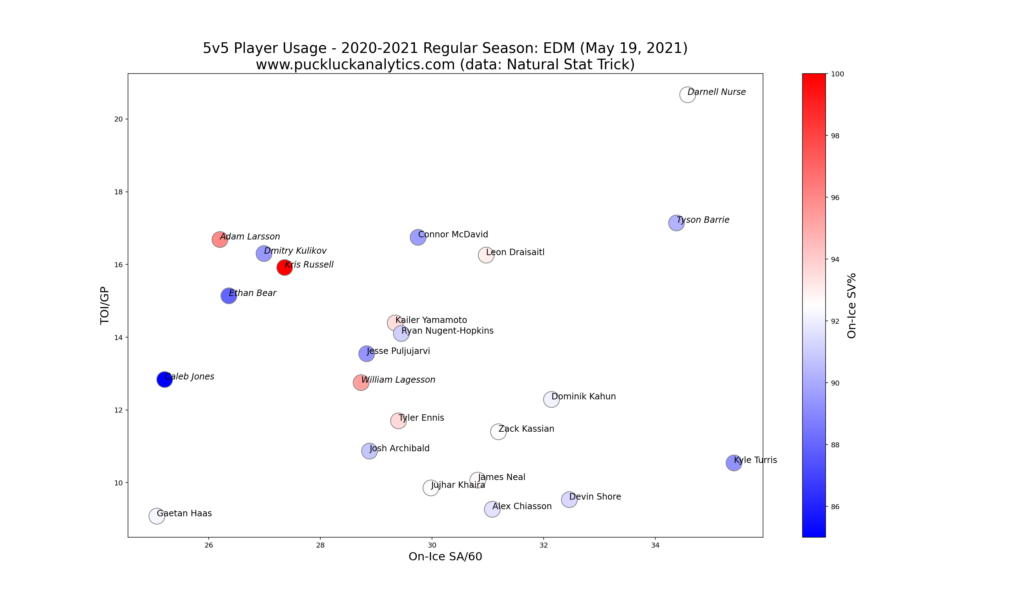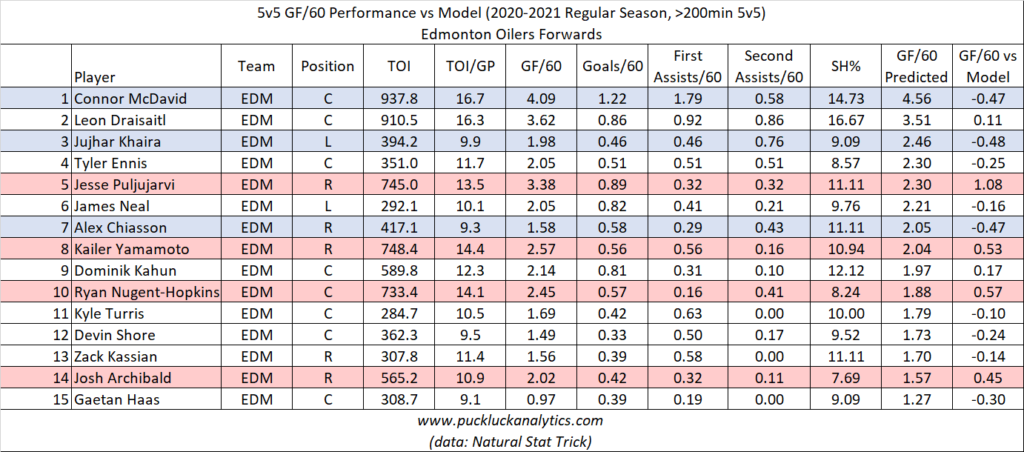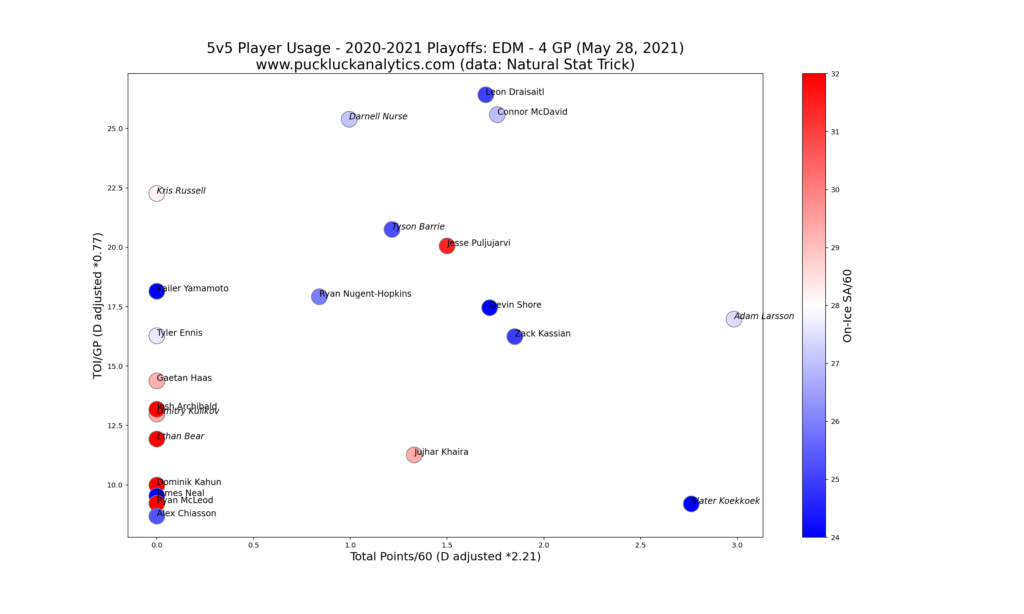Connor McDavid had an incredible season in Edmonton, breaking 100pts in the shortened 56 game season. Alas, the Oilers offense ran dry in the first round against the Jets and the team made another early exit from the playoffs. With McDavid in his prime, what do the Oilers need to change to build a true contender around him? If you haven’t read it already, I encourage you to check out this post that has more detail on the plots we’ll look as we go though our Oilers season review.
Overall Performance (Regular Season)
Looking at the Oilers regular season performance relative to our points predictor model is the first place we’ll look to start digging into the Oilers’ season. The model uses only 5v5 goal rates as input, so it gives us an indication of the strength of the full depth of the team.
The Oilers outperformed the model by the largest amount in the league by a significant margin. Since the points predictor model uses only 5v5, factors like special teams and overtime results can be causes of variance. With the top end talent the Oilers have in McDavid and Leon Draisaitl, their powerplay is a likely culprit here. The concerning issue for the Oilers is that, based on their 5v5 play, the model doesn’t even put them in a playoff position in the North.
Let’s look at the 5v5 goal rates that feed the model.
The Oilers’ 5v5 offense was good, but not as good as we might expect after considering McDavid’s point totals mentioned off the top. Their defense was not strong, however, and it contributed to their very average goals for percentage. To achieve better results next season, it’s clear the Oilers need to improve defensively. Considering McDavid’s offensive contribution, it also looks like there is room for improvement offensively through the rest of the lineup.
Player Performance (Regular Season)
We’ll start evaluting player performance by looking at a 5v5 usage chart with defencemens’ stats factored for comparison with forwards. The result is a visual depth chart where we should see the top players at the top right and the rest of the players distributed along a diagonal from there.
McDavid stands out on the chart as the best player, as expected. Draisaitl, Darnell Nurse and Tyson Barrie also stand out well above the rest of the roster. After the top players, there is a large drop in point production and the diagonal distribution is closer to vertical, indicating players weren’t utilized as effectively as possible. For example, it’s not clear why Kailer Yamamoto and Ryan Nugent-Hopkins received so much more 5v5 ice time than James Neal and Jujhar Kharia from this plot. The latter two players actually had higher point production rates than the first two.
By plotting on-ice GF/60 vs TOI/GP we get a visual of the relative offensive impacts of each player. Players closer to the top right contributed more to the team GF/60.
We see Jesse Puljarvi join the four players at the top of the last chart on this one. These five players had significantly larger contributions to the Oilers 5v5 offense than the rest of the roster did. Among the depth players, there doesn’t seem to be much difference in offensive impact as we once again see more of a vertical distribution instead of diagonal. We’re getting a sense that after the first line and top D pairing, the rest of the Oilers roster is made up of players that are all of a very similar skill level.
To get a similar visual for contribution to team defense, we’ll plot on-ice SA/60 vs TOI/GP. This time, the better contributions are further left and down.
It’s re-assuring to see the Oilers offensive forwards near the middle of this chart, indicating they had relatively average impacts on team defense compared to the other forwards on the team. With on-ice SA/60 for the forwards generally near the league average of 30, the team could stand to shift these numbers to the left on the whole. Looking at defensemen, we see a different story. Nurse and Barrie are at the far right of the chart, with the worst defensive impacts on the team. With their large roles, they need to provide more stability defensively. Meanwhile, the rest of the Oilers defensemen are grouped on the left side of the chart, with much better defensive impacts which give us cause to question whether the Oilers’ defensemen we utilized optimally.
Looking at our on-ice GF/60 model relative to actual numbers gives us an indication of which players carried their line mates offensively. Variances greater than about 0.3 are notable and negative variances indicate a player carrying his line mates.
Connor McDavid is, unsurprisingly, at the top of the list for GF/60 predicted by the model and he has a variance that indicates he carried his linemates. Juhjar Khaira and Alex Chaisson also stand out in this fashion and look like they were key players in the Oilers’ bottom six. On the flip side, we see Ryan Nugent-Hopkins, Jesse Puljujarvi, Kailer Yamamoto and Josh Archibald stand out as having been carried by their line mates. Most of these players had significant time playing with McDavid. Hold that thought and we’ll come back to it in a moment.
Among defensemen, we see Nurse and Barrie stand out as being carried by their line mates. With the Oilers often preferring a five man unit playing with McDavid, they saw significant time with him as well. Again, hold the thought for a moment. We also see that Adam Larsson, Caleb Jones, and Kris Russell appear to have had positive effects on their line mates.
Now back to the McDavid effect. We’re going to look at an additional chart for the Oilers, combining the two above for players who saw significant ice time with McDavid.
This chart puts some perspective into just how dominant McDavid’s season was. He clearly had a large impact on his line mates and many of them undoubtedly put up better individual numbers as a result. Based on our model, Draisaitl appears to be the only player who spent significant time with McDavid who pulled his own weight offensively. While we have seen some similar effects on other teams, like Patrick Kane’s impact on the Blackhawks young forwards, the magnitude of McDavid’s impact on his teammates is on a whole different level.
Mikko Koskinen carried the load in goal for the Oilers early in the season while Mike Smith was injured and the he and the team both struggled during that stretch. Mike Smith’s strong play when he returned seemed to turn things around for the Oilers. In order to improve their overall defensive numbers, the Oil will need better performance from their backup next season to bring their overall goaltending impacts up.
Playoff Performance
While four games doesn’t provide us with enough data to make any projections for future performance, taking a look at the Oilers’ playoff performance can give us some insight into what went wrong against the Jets.
The Oilers’ superstars weren’t able to produce at the rate they did in the regular season in the series against the Jets. To make matters worse, not many of their depth players were able to find the scoresheet either. Off the top of our review, we saw our points predictor model saw the Oilers and Jets as very closely matched at 5v5 and that’s essentially how the series played out, with three of four games going to OT.
Looking Ahead
With just under $60M committed to the 2021-2022 cap, the Oilers have some room to work with this offseason to improve the team. However, a large number of expiring deals mean the Oil also have a lot of holes to fill.
Key RFAs:
Khaira, Yamamoto, Dominic Kahun and Devin Shore are all restricted free agents this offseason. We saw signs that Khaira carried his line mates offensively and he looks like he was under-utilized slightly this season. He should continue to fit nicely as a bottom six forward. The Oilers need to exercise some caution with Yamamoto. We saw he was carried by his line mates and the Oil will need to be careful they don’t sign him for more than his true value. It looks like he is probably a better fit in the bottom six than riding shotgun with McDavid or Draisaitl.
Key UFAs:
Nugent-Hopkins is the most notable among six UFA Oiler forwards. A former first overall pick, Nugent-Hopkins will likely find a significant payday on the open market. However, we didn’t see him stand out from the depth players in our review and it may be difficult to justify the cost of his next contract. The Oilers may be best off to let him walk and use the cap space more efficiently.
The Oilers also have four UFA defensemen, including Adam Larsson and Tyson Barrie. Larsson showed signs of having a positive impact in our review and the Oilers would do well to keep him provided the resulting cap hit is reasonable. Barrie, on the other hand, is one of the players we noted saw big impacts from playing with McDavid and could easily be offered more than his true value this summer.
Finally, Mike Smith is also a UFA. GM Ken Holland has stated publicly that he would like to bring Smith back next season. Based on this season’s performance, it’s easy to see why the Oilers would like to bring him back. However, with Smith now 41, signing him comes with significant risk that father time will catch up and a significant drop in play results.
Tough Questions
Should the Oilers re-sign Ryan Nugent-Hopkins? The former first overall pick has been a staple in Edmonton for a decade. Often flying under the radar below the Oilers other stars, he put up 69 points for his best season in 2018-2019. With production this season similar to the Oiler’s bottom six at 5v5 and signs that his numbers may be somewhat inflated due to playing with McDavid and Draisaitl, is it time for ‘Nuge’ and the Oil to part ways?
Offseason Priority
The Oilers need to bring in some secondary scoring to take the pressure off McDavid and Draisaitl. We saw a huge talent gap in the usage chart and some signs that the Oilers’ next best player’s numbers may even be inflated just by playing with McDavid. Bringing in a few such players would also help their defensive numbers since they would be more likely to win the possession game while McDavid is not on the ice.
Check out my other offseason reviews, such as the Calgary Flames and the Vancouver Canucks, and subscribe to catch the rest of my season reviews as they come out.
data: Natural Stat Trick
cap data: CapFriendly
